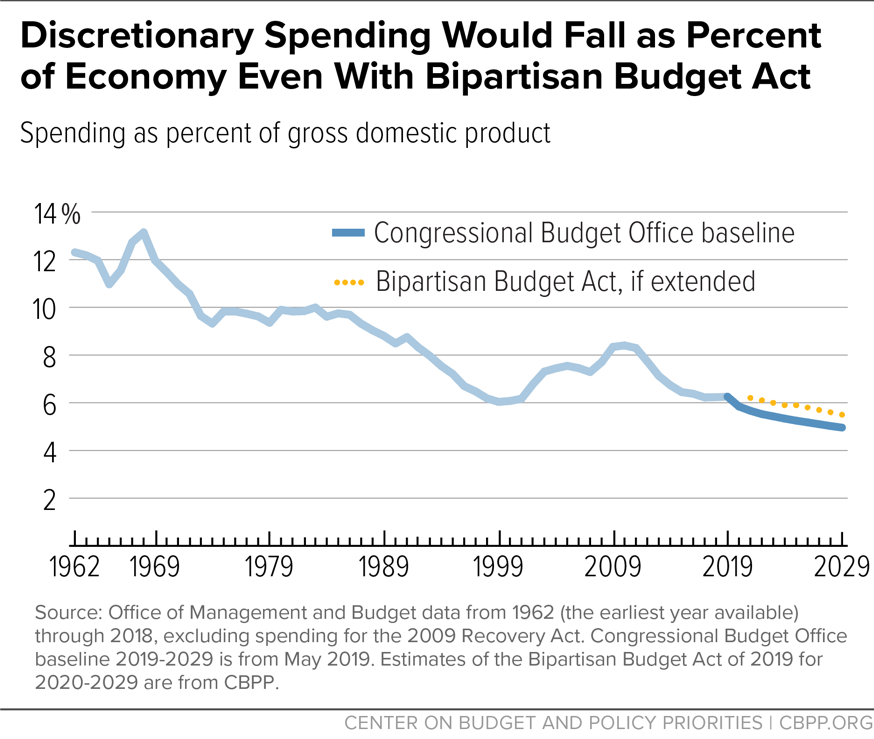BEYOND THE NUMBERS
Discretionary spending will be near historic lows as a percent of the economy in 2020 and 2021 even with the added funding that the new bipartisan budget agreement (the Bipartisan Budget Act of 2019), now awaiting the President’s signature, provides for those years. And even if the 2021 funding levels grow with inflation in later years, discretionary spending will fall to its lowest level on record as a share of the economy (in data going back to 1962) within a few years (see chart).
Some have warned that the agreement would add substantially to the debt if its increases continued over the next decade. How could a bill that would reduce discretionary spending relative to the size of the economy increase the debt?
The answer lies with the mechanical way that the Congressional Budget Office (CBO) projects discretionary spending levels in future years. The current CBO baseline assumes that funding each year adheres to the 2011 Budget Control Act (BCA), which imposed annual dollar limits (or caps) separately on defense and non-defense discretionary (NDD) funding for years through 2021. Those caps proved too tight, so a series of bipartisan agreements have raised the caps each year since 2013. But CBO’s most recent baseline estimates, released in May, assumed both that the BCA caps for 2020 and 2021 would be in effect and that these very low funding levels — far below the level of funding actually enacted in 2019 — would remain in effect in every year after 2021, adjusted only for inflation.
In short, the higher discretionary funding levels in the budget agreement (if extended over the next decade) would cost substantial amounts over ten years relative to the BCA’s funding path, which two Presidents and Congress repeatedly rejected as considerably too low.
In August, CBO will update its May baseline estimates to reflect the higher 2020 and 2021 funding levels in the new budget agreement and will assume that the newly agreed upon 2021 level will grow with inflation for the rest of the decade. As the chart above shows, the new agreement will raise defense and NDD spending above the low levels reflected in CBO’s May baseline, but will still put overall discretionary spending on a generally downward path as a percent of the economy.
In assessing the budget agreement, it’s also worth considering the cost of the 2017 tax law, which reduced revenues to historically low levels. Revenues fell to 16.5 percent of the economy in 2019, well below the 18.4 percent average over the past four decades for years when the economy is strong, as it is today. While most of the tax cuts for individuals expire after 2025, the Trump budget calls for making them permanent. Based on CBO estimates of the cost of making the tax cuts permanent, in 2029 that cost would be nearly 60 percent more than the added discretionary spending that year resulting from the budget agreement (assuming the agreement’s funding levels grow with inflation after 2021). And while the budget agreement addresses historically low levels of investment in some key discretionary programs, extending the expiring 2017 tax cuts would extend historically low levels of revenue, exacerbating the revenue shortfalls and costing much more than the added spending from the budget agreement.

